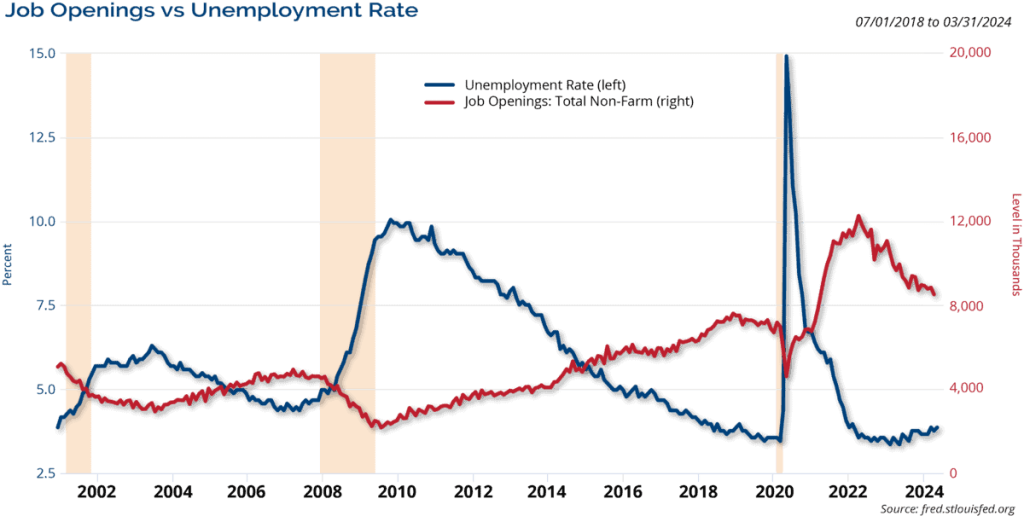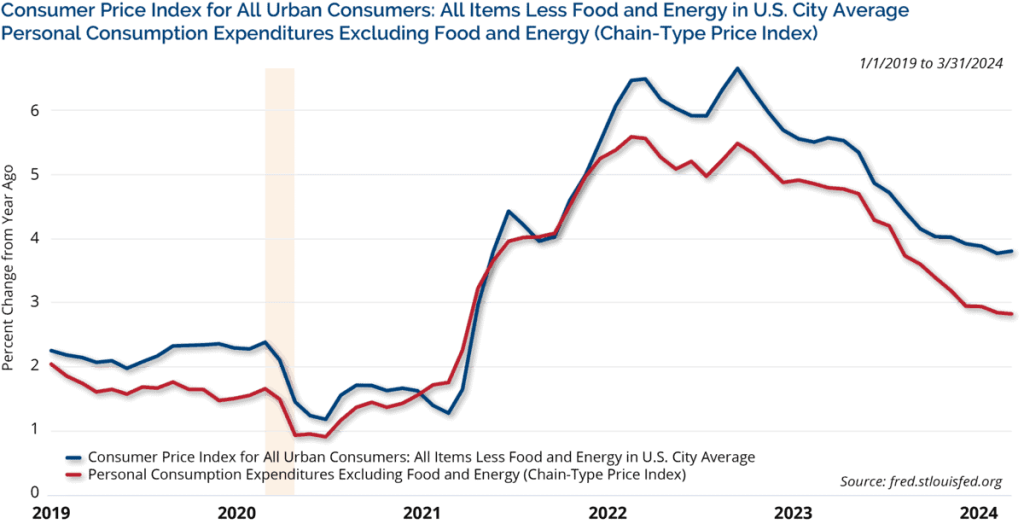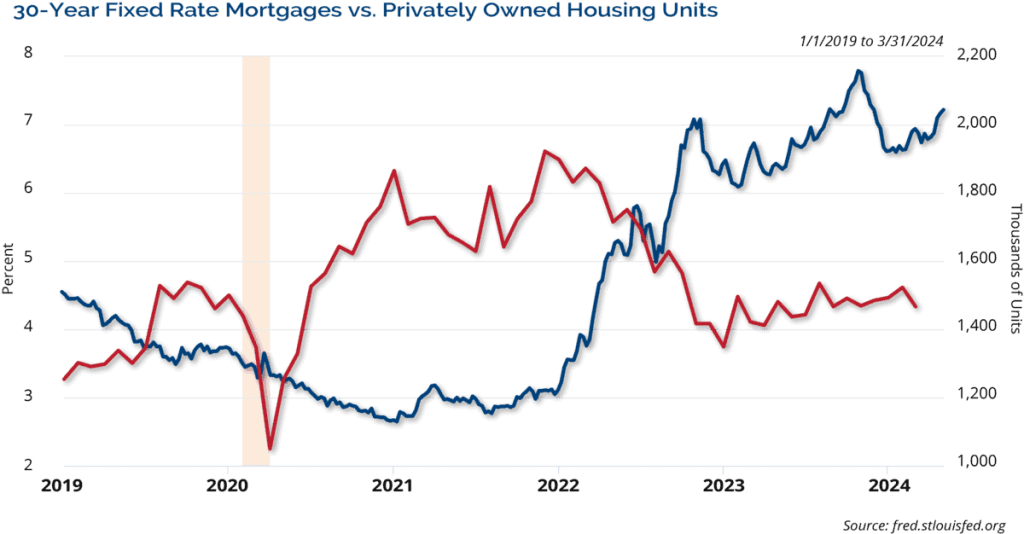Stocks Decline in April as Bonds Struggle with Rising Rates
HIGHLIGHTS:
- After posting all-time highs in March and strong results for the first quarter, the major stock indices declined in April. The five-month streak of stock market gains starting last November was broken; however, this pause in the market run was not unexpected.
- Bonds struggled again in April as rates continued to rise. After slipping modestly in March to close the month at 4.20%, the 10-year U.S. Treasury yield rose sharply to close April at 4.69%.
- The U.S. economy showed ongoing growth, but displayed some mixed signals when data was reported in April. The first estimate of Q1 2024 GDP was disappointing at 1.6%, but the ISM Manufacturing Index turned positive in March for the first time in 16 months.
- The FOMC meeting concluded on May 1st as expected with no change in rates. Market expectations have fallen dramatically on the number of rate cuts expected in 2024 and was down to just one expected cut as April concluded.
EQUITY MARKETS
The five-month winning streak for stocks was broken in April as U.S. equities were lower across the board for the month. Market sentiment readings had become excessively bullish (a contrarian indicator) and were flashing a warning signal that some market volatility might be coming in the near term.
We believe the modest correction in April was most likely the market consolidating gains after a powerful run from the October lows. In other words, we still believe that market fundamentals are solid and believe that Aprils decline was a normal market consolidation. Weakness was seen broadly in stocks in April with small-caps weaker than large-caps, but style was of little consequence for the month. However, growth still showed better relative year-to-date results compared to value. International stocks fared relatively better than U.S. stocks in April, which has been rare in recent years. See Table 1 for equity results for April 2024, year to date and calendar year 2023.
Table 1
| Index | 24-Apr | YTD | 2023 |
| S&P 500 | -4.08% | 6.04% | 26.29% |
| S&P 500 Equal Weight | -4.87% | 2.66% | 13.87% |
| DJIA | -4.92% | 0.92% | 16.18% |
| Russell 3000 | -4.40% | 5.18% | 25.96% |
| NASDAQ Comp. | -4.38% | 4.52% | 44.64% |
| Russell 2000 | -7.04% | -2.22% | 16.93% |
| MSCI ACWI ex U.S. | -1.80% | 2.81% | 15.62% |
| MSCI Emerging Mkts Net | 0.45% | 2.83% | 9.83% |
2023 will be remembered for the dominance of large-cap growth and 2024 has continued in a similar fashion. Small-caps have struggled so far this year and were among the weakest pockets of the stock market in April. Emerging markets were able to post a modest gain for the month. We see opportunities in international markets with valuations that are lower than the U.S. and our expectation that the U.S. dollar will likely weaken over the short to intermediate term as the Fed begins cutting rates. We also believe that we could see the market broaden in 2024 with valuations more compelling in value, small-cap, mid-cap and international stocks.
Fixed Income
The ongoing delay in Fed rate cuts paired with somewhat disappointing inflation data have pushed rates higher in 2024. The rally in bonds to close out 2023 sent the 10-year U.S. Treasury yield sharply lower and it closed last year at 3.88%. The 10-year U.S. Treasury yield ended March at 4.20%, and it rose to 4.69% by the end of April.
Outside of March, yields have moved higher in 2024, which has put most bond sectors into the red so far this year. High yield bonds stand out as the one positive bond sector year to date, but even high yield bonds declined in April with such a sharp move higher in rates. See Table 2 for fixed income index returns for April 2024, year to date, and calendar year 2023.
Table 2
| Index | 24-Apr | YTD | 2023 |
| Bloomberg U.S. Agg | -2.53% | -3.28% | 5.53% |
| Bloomberg U.S. Credit | -2.49% | -2.89% | 8.18% |
| Bloomberg U.S. High Yld | -0.94% | 0.52% | 13.44% |
| Bloomberg Muni | -1.24% | -1.62% | 6.40% |
| Bloomberg 30-year U.S. TSY | -6.68% | -10.46% | 1.93% |
| Bloomberg U.S. TSY | -2.33% | -3.26% | 4.05% |
High yield bonds often follow what is happening with stocks, so they have been able to buck the trend experienced by most areas of the bond market so far in 2024 and remain modesty in positive territory year to date. The other areas of the bond market have been impacted by the general move higher in rates in 2024, and particularly the sharp move higher in April.
The 30-year U.S. Treasury Index was most impacted with rates moving higher with a monthly decline of -6.68% and year-to-date results down almost -10.5%. We expect the 10-year U.S. Treasury yield will be in a range between 3.25% and 4.5% during the year (acknowledging we are slightly above this range at the end of April), and we believe the trend will be lower as we continue to move through 2024.
We also believe that rates at the front end of the yield curve, which have not moved too dramatically, will decline as the Fed begins to cut rates later in 2024. However, those first rate cuts were moved further out in the year based on market expectations.
We maintain our long-standing position favoring credit versus pure rate exposure in this interest rate environment and that has served us well so far in 2024. We also believe the role bonds play in a portfolio, which is to provide stable cash flow and to help offset the volatility of stocks in the long run, has not changed. Furthermore, we believe that bond yields remain attractive and the recent move higher in rates is providing another chance to capture some of the better bond yields we have seen in years. In our opinion, having an active bond management approach makes sense in these volatile times.
Economic Data and Outlook
Data released in April (largely covering March), continued to show an economy that was growing, but some results were mixed. The first reading of Q1 2024 GDP was disappointing at a 1.6% annualized growth rate with expectations at 2.5%. Personal consumption was one area that disappointed. This GDP report will be revised two more times in the months ahead, but if it were to hold, it would break a streak of 6 straight quarters with GDP above 2%. The Atlanta Fed GDPNow estimate for economic growth (as of April 1) shows the economy running at an estimated 3.3% growth rate for the second quarter of 2024. Clark Capitals GDP growth expectation for 2024 is at 2.25%. We do expect growth to slow in 2024, but we also think the odds favor a soft landing and not a recession at this point.
One ongoing reason we continue to expect growth in the economy comes from ongoing gains in the job market. Non-farm payroll additions were 303,000 in March, easily surpassing expectations of 214,000. The unemployment rate moved down to 3.8% as expected and was a modest improvement from the prior months level of 3.9%. Average hourly earnings grew by 4.1% on an annual basis in March as expected. As a consumer-based economy, the strength in the job market has been a key driver of economic growth.
Some moderation in the job market could allow the Fed to cut rates sooner rather than later, but job market data has not weakened to much of any degree at this point. We are still in a situation with millions more job openings than unemployed people in the U.S. economy. The latest JOLTS reading of job openings for March declined to 8.488 million from 8.813 million the prior month. Chart 1 shows the unemployment rate and job openings. As job openings have come down over the last couple of years, we have seen only a modest tick up in the unemployment rate.
Chart 1

With the current strength in the job market, we maintain our opinion that it seems unlikely that the economy would slow too drastically. We continue to expect that the economy will slow from its pace in 2023, but that it will still grow in 2024 resulting in a soft landing. Even if a recession developed, we believe it would be mild due to the strength of the consumer. We believe opportunities exist in the stock and bond markets under either a slow growth or mild recession scenario, but we believe the odds favor a soft landing at this point.
Inflation data for March was modestly above expectations. Generally higher than expected inflation readings so far this year have been the primary driver in the delay in the Fed cutting interest rates. The headline Consumer Price Index (CPI) showed an annual increase of 3.5% in March, which was higher than expectations of 3.4% and above the February level of 3.2%. The core CPI showed an annual gain of 3.8% compared to expectations of 3.7%, but this matched the prior month.
The headline Producer Price Index (PPI) rose by 2.1% on an annual basis in March, better (lower) than the 2.2% expectation, but above the prior month’s 1.6% annual increase. The core PPI had an annual increase of 2.4%, higher than expectations of 2.3% and also above the prior month’s 2.1%. We do not expect this sort of data to decline in a straight line and some periods of volatility should be expected. We would argue that the trend is still showing improvements made regarding inflation and we believe that the next move by the Fed will be a rate cut — it will just be later than most expected at the beginning of the year.
Focusing on the preferred inflation measure of the Fed, the Personal Consumption Expenditures (PCE) Index for March was modestly higher than expectations. The headline PCE Index had an annual increase of 2.7% in March, above the 2.6% expectation. The core PCE reading (the reading the Fed targets) was 2.8% — again, slightly higher than the expectation of 2.7%. The headline reading was higher than the February annual increase, while the core reading matched the prior month. Chart 2 shows the core PCE Price Index and the core CPI, which have both been trending lower since their rapid rise following the pandemic period, but the pace of decline has slowed.
Chart 2

Progress has been made on the inflation front. The Fed has indicated it believes the rate hike cycle is over and rate cuts will occur in 2024. Four months into the year, market expectations, according to the CME FedWatch Tool, have dropped to show only 1 expected cut in 2024 with additional cuts coming in 2025. That is a far cry from where the year began when the market was anticipating too many cuts (6 or 7) compared to what the Fed was indicating through its “dot plot” projections of about 3.
The June FOMC meeting will have updated economic projections from Fed officials, and we believe they will lower their expectations for 3 potential cuts in 2024. It is notable that stocks logged a strong quarter even as rate cut expectations have been trimmed, but stocks slipped lower in April and the cause of some of that weakness could be due to the ongoing reduction of expected rate cuts.
The housing market seems to be fighting against higher mortgage rates and housing data was generally weaker in March. Building permits, housing starts, and existing home sales were all below expectations and lower than February levels. New home sales were able to improve last month to an annual rate of 693,000 compared to expectations of 668,000 and the prior month’s revised level of 637,000. The S&P CoreLogic 20-City Index of home prices rose by 7.29% on an annual basis in February, well ahead of expectations of 6.70% and the prior month’s annual increase of 6.58%. It will be important to see how housing reacts with the significant move higher in interest rates in April. Chart 3 shows the recent increase in mortgage rates, and it will be important to watch if higher rates weaken housing market activity, like building permits.
Chart 3

The ISM Manufacturing Index for March broke the streak of 16 straight months of manufacturing declines when it posted a reading of 50.3. This was above expectations of 48.3 and was driven higher in part by better-than-expected new orders. (Unfortunately, the reading for April slipped below the 50 mark once again to 49.2 when it was expected to be right at 50.)
The ISM Non-Manufacturing Index, which covers the much larger service industries in the U.S. economy, slipped to 51.4 in March, which missed expectations of 52.8 and was a drop from 52.6 in February. The service industries have consistently shown growth in recent years, but the pace of growth has slowed in recent months. The surprise growth in manufacturing in March was a welcome sign, but we acknowledged at the time that one month is not a trend, and we saw it slip back below 50 in April. Recall, the dividing line between expansion and contraction for the ISM indices is 50.
Retail sales (ex. auto and gas) grew by 1.0% in March, easily surpassing expectations of 0.3% and the prior month was revised to show a 0.6% gain from the prior estimate of 0.3%. The preliminary University of Michigan Sentiment reading for April ticked lower to 77.9 from the prior month reading of 79.4 and expectations of 79.0. After breaking a two-year streak of declines in February, the Conference Board’s Leading Index fell once again in March by -0.3% when a -0.1% decline was anticipated. As always, we believe it is imperative for investors to stay focused on their long-term goals and not let short-term swings in the market derail them from their longer-term objectives.
Investment Implications
Clark Capitals Top-Down, Quantitative Strategies
The S&P 500 advanced by over 28% in a 21-week rally from 10/27/23 to 3/28/24 in which there was not even a 2% correction. We do know that the markets are cyclical, and on average, the S&P 500 has experienced three 5% corrections a year, a 10% decline once a year, a 15% decline every 2 years, and a 20% or greater bear market every three years.
In April, the S&P 500 had a 5% drawdown into mid-month and as a result, seeds of fear were replanted with investor sentiment statistics turning pessimistic. During the correction, credit markets continued showing relative strength, even as interest rates rose.
Clark Capitals Bottom-Up, Fundamental Strategies
After two strong quarters, the S&P 500 Index declined -4.0% in April due to higher market valuation, rising employment costs and persistent inflation concerns. Equities retreated in April as higher interest rates across both U.S. Treasury and credit yield curves now present a competitive alternative to stocks. At this stage of the market cycle, factors such as free cash flow yield, ROE, and earnings growth tend to outperform prior to a Fed pivot.
ECONOMIC DATA
| Event | Period | Estimate | Actual | Prior | Revised |
| ISM Manufacturing | Mar | 48.3 | 50.3 | 47.8 | — |
| ISM Services Index | Mar | 52.8 | 51.4 | 52.6 | — |
| Change in Nonfarm Payrolls | Mar | 214k | 303k | 275k | 270k |
| Unemployment Rate | Mar | 3.80% | 3.80% | 3.90% | — |
| Average Hourly Earnings YoY | Mar | 4.10% | 4.10% | 4.30% | — |
| JOLTS Job Openings | Mar | 8680k | 8488k | 8756k | 8813k |
| PPI Final Demand MoM | Mar | 0.30% | 0.20% | 0.60% | — |
| PPI Final Demand YoY | Mar | 2.20% | 2.10% | 1.60% | — |
| PPI Ex Food and Energy MoM | Mar | 0.20% | 0.20% | 0.30% | — |
| PPI Ex Food and Energy YoY | Mar | 2.30% | 2.40% | 2.00% | 2.10% |
| CPI MoM | Mar | 0.30% | 0.40% | 0.40% | — |
| CPI YoY | Mar | 3.40% | 3.50% | 3.20% | — |
| CPI Ex Food and Energy MoM | Mar | 0.30% | 0.40% | 0.40% | — |
| CPI Ex Food and Energy YoY | Mar | 3.70% | 3.80% | 3.80% | — |
| Retail Sales Ex Auto and Gas | Mar | 0.30% | 1.00% | 0.30% | 0.60% |
| Industrial Production MoM | Mar | 0.40% | 0.40% | 0.10% | 0.40% |
| Building Permits | Mar | 1510k | 1458k | 1518k | 1523k |
| Housing Starts | Mar | 1485k | 1321k | 1521k | 1549k |
| New Home Sales | Mar | 668k | 693k | 662k | 637k |
| Existing Home Sales | Mar | 4.20m | 4.19m | 4.38m | — |
| Leading Index | Mar | -0.10% | -0.30% | 0.10% | 0.20% |
| Durable Goods Orders | Mar P | 2.50% | 2.60% | 1.30% | 0.70% |
| GDP Annualized QoQ | 1Q A | 2.50% | 1.60% | 3.40% | — |
| U. of Mich Senitment | Apr P | 79 | 77.9 | 79.4 | — |
| Personal Income | Mar | 0.50% | 0.50% | 0.30% | — |
| Personal Spending | Mar | 0.60% | 0.80% | 0.80% | — |
| S&P CoreLogic CS 20-City YoY NSA | Feb | 6.70% | 7.29% | 6.59% | 6.58% |
Source: Bloomberg: A=Advanced, P=Preliminary
Past performance is not indicative of future results. The opinions referenced are as of the date of publication and are subject to change due to changes in the market or economic conditions and may not necessarily come to pass. Material presented has been derived from sources considered to be reliable and has not been independently verified by us or our personnel. Nothing herein should be construed as a solicitation, recommendation or an offer to buy, sell or hold any securities, other investments or to adopt any investment strategy or strategies. Investors must make their own decisions based on their specific investment objectives and financial circumstances. Investing involves risk, including loss of principal.
Clark Capital Management Group is an investment adviser registered with the U.S. Securities and Exchange Commission. Registration does not imply a certain level of skill or training. More information about Clark Capital Management Group’s advisory services can be found in its Form ADV which is available upon request.
Fixed income securities are subject to certain risks including, but not limited to: interest rate (changes in interest rates may cause a decline in market value or an investment), credit, prepayment, call (some bonds allow the issuer to call a bond for redemption before it matures), and extension (principal repayments may not occur as quickly as anticipated, causing the expected maturity of a security to increase).
Clark Capital utilizes a proprietary investment model to assist with the construction of the strategy and to assist with making investment decisions. Investments selected using this process may perform differently than expected as a result of the factors used in the model, the weight placed on each factor, and changes from the factors historical trends. There is no guarantee that Clark Capital’s use of a model will result in effective investment decisions.
Non-investment-grade debt securities (high-yield/junk bonds) may be subject to greater market fluctuations, risk of default or loss of income and principal than higher-rated securities.
Foreign securities are more volatile, harder to price and less liquid than U.S. securities. They are subject to different accounting and regulatory standards and political and economic risks. These risks are enhanced in emerging market countries.
The value of investments, and the income from them, can go down as well as up and you may get back less than the amount invested.
Equity securities are subject to price fluctuation and possible loss of principal. Stock markets tend to move in cycles, with periods of rising prices and periods of falling prices. Certain investment strategies tend to increase the total risk of an investment (relative to the broader market). Strategies that concentrate their investments in limited sectors are more vulnerable to adverse market, economic, regulatory, political, or other developments affecting those sectors.
JOLTS is a monthly report by the Bureau of Labor Statistics (BLS) of the U.S. Department of Labor counting job vacancies and separations, including the number of workers voluntarily quitting employment.
The Core Consumer Price Index (CPI) is a measure of the average change over time in the prices paid by urban consumers for a market basket of consumer goods and services.
The Core Producer Price Index (PPI) program measures the average change over time in the selling prices received by domestic producers for their output. The prices included in the PPI are from the first commercial transaction for many products and some services.
The PCE price index, released each month in the Personal Income and Outlays report, reflects changes in the prices of goods and services purchased by consumers in the United States.
Earnings per share (EPS) is a company’s net profit divided by the number of common shares it has outstanding.
References to market or composite indices, benchmarks or other measures of relative market performance over a specified period of time (each, an “index”) are provided for your information only. Reference to an index does not imply that the portfolio will achieve returns, volatility or other results similar to that index. The composition of the index may not reflect the manner in which a portfolio is constructed in relation to expected or achieved returns, portfolio guidelines, restrictions, sectors, correlations, concentrations, volatility or tracking error targets, all of which are subject to change. Investors cannot invest directly in an index.
The Dow Jones Industrial Average® (The Dow®), is a price-weighted measure of 30 U.S. blue-chip companies. The index covers all industries except transportation and utilities.
The Bloomberg Barclays U.S. Municipal Index covers the USD-denominated long-term tax exempt bond market. The index has four main sectors: state and local general obligation bonds, revenue bonds, insured bonds and prerefunded bonds.
The Bloomberg US Treasury Index measures US dollar-denominated, fixed-rate, nominal debt issued by the US Treasury. Treasury bills are excluded by the maturity constraint, but are part of a separate Short Treasury Index.
The Dow Jones Industrial Average indicates the value of 30 large, publicly owned companies based in the United States.
The NASDAQ Composite is a stock market index of the common stocks and similar securities listed on the NASDAQ stock market.
The S&P 500 measures the performance of the 500 leading companies in leading industries of the U.S. economy, capturing 80% of U.S. equities.
The S&P 500® Equal Weight Index (EWI) is the equal-weight version of the widely-used S&P 500. The index includes the same constituents as the capitalization weighted S&P 500, but each company in the S&P 500 EWI is allocated a fixed weight — or 0.2% of the index total at each quarterly rebalance.
The University of Michigan Consumer Sentiment Index rates the relative level of current and future economic conditions. There are two versions of this data released two weeks apart, preliminary and revised. The preliminary data tends to have a greater impact. The reading is compiled from a survey of around 500 consumers.
The Russell 1000 Index is a stock market index that tracks the highest-ranking 1,000 stocks in the Russell 3000 Index, which represent about 93% of the total market capitalization of that index.
The iShares Russell 1000 Growth ETF seeks to track the investment results of an index composed of large- and mid-capitalization U.S. equities that exhibit growth characteristics.
The Russell 1000 Value Index measures the performance of the large-cap value segment of the U.S. equity universe. It includes those Russell 1000 Index companies with lower price-to-book ratios and lower forecasted growth values.
The Russell 2000 Index is a small-cap stock market index that represents the bottom 2,000 stocks in the Russell 3000.
The Russell 3000 Index measures the performance of the 3,000 largest U.S. companies based on total market capitalization, which represents approximately 98% of the investable U.S. equity market.
Nonfarm payrolls (NFPs) are the measure of the number of workers in the United States excluding farm workers and workers in a handful of other job classifications.
A municipal bond, commonly known as a muni, is a bond issued by state or local governments, or entities they create such as authorities and special districts.
The U.S. Treasury index is based on the recent auctions of U.S. Treasury bills. Occasionally it is based on the U.S. Treasury’s daily yield curve.
The 30 Year Treasury Rate is the yield received for investing in a US government issued treasury security that has a maturity of 30 years.
The 10 Year Treasury Yield is the yield received for investing in a US government issued treasury security that has a maturity of 10 year. The 10 year treasury yield is included on the longer end of the yield curve. Many analysts will use the 10 year yield as the “risk free” rate when valuing the markets or an individual security.
The Bloomberg Barclays U.S. Corporate High-Yield Index covers the U.S. dollar-denominated, non-investment grade, fixed-rate, taxable corporate bond market. Securities are classified as high-yield if the middle rating of Moody’s, Fitch, and S&P is Ba1/BB+/BB+ or below.
The Bloomberg Barclays U.S. Credit Index measures the investment grade, U.S. dollar denominated, fixed-rate taxable corporate and government related bond markets.
The Bloomberg Aggregate Bond Index or the Agg is a broad-based fixed-income index used by bond traders and the managers of mutual funds and exchange-traded funds (ETFs) as a benchmark to measure their relative performance.
The Bloomberg US Trsy Bellwethers 30Y is a U.S. Treasury debt obligation that has a maturity of 30 years.
The ISM Non-Manufacturing Index is an index based on surveys of more than 400 non-manufacturing firms purchasing and supply executives, within 60 sectors across the nation, by the Institute of Supply Management (ISM). The ISM Non-Manufacturing Index tracks economic data, like the ISM Non-Manufacturing Business Activity Index. A composite diffusion index is created based on the data from these surveys, that monitors economic conditions of the nation.
ISM Manufacturing Index measures manufacturing activity based on a monthly survey, conducted by Institute for Supply Management (ISM), of purchasing managers at more than 300 manufacturing firms.
The MSCI Emerging Markets Index captures large and mid cap representation across 27 Emerging Markets (EM) countries.
The MSCI ACWI ex USA Index captures large and mid cap representation across 22 of 23 Developed Markets (DM) countries (excluding the US) and 27 Emerging Markets (EM) countries*. With 2,359 constituents, the index covers approximately 85% of the global equity opportunity set outside the US
The S&P CoreLogic Case-Shiller 20-City Composite Home Price NSA Index seeks to measures the value of residential real estate in 20 major U.S. metropolitan areas. The U.S. Treasury index is based on the recent auctions of U.S. Treasury bills. Occasionally it is based on the U.S. Treasury’s daily yield curve.
The Leading Economic Index provides an early indication of significant turning points in the business cycle and where the economy is heading in the near term.
In the United States, the Core Personal Consumption Expenditure Price (CPE) Index provides a measure of the prices paid by people for domestic purchases of goods and services, excluding the prices of food and energy.
The VIX Index is a calculation designed to produce a measure of constant, 30-day expected volatility of the U.S. stock market, derived from real-time, mid-quote prices of S&P 500® Index (SPX?) call and put options. On a global basis, it is one of the most recognized measures of volatility — widely reported by financial media and closely followed by a variety of market participants as a daily market indicator.
The Conference Board’s Leading Indexes are the key elements in an analytic system designed to signal peaks and troughs in the business cycle. The leading, coincident, and lagging economic indexes are essentially composite averages of several individual leading, coincident, or lagging indicators. They are constructed to summarize and reveal common turning point patterns in economic data in a clearer and more convincing manner than any individual component — primarily because they smooth out some of the volatility of individual components.
Gross domestic product (GDP) is the standard measure of the value added created through the production of goods and services in a country during a certain period.




